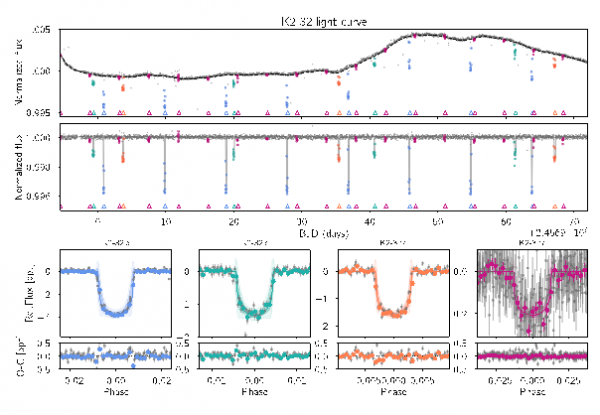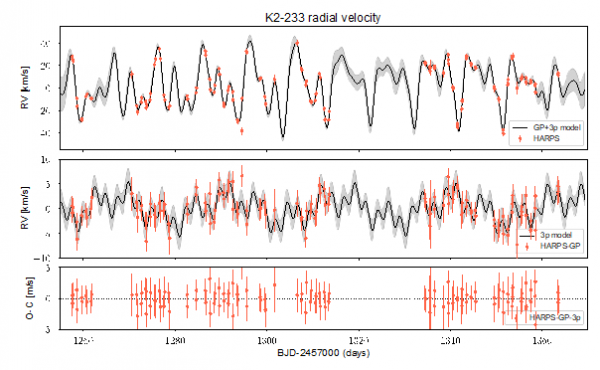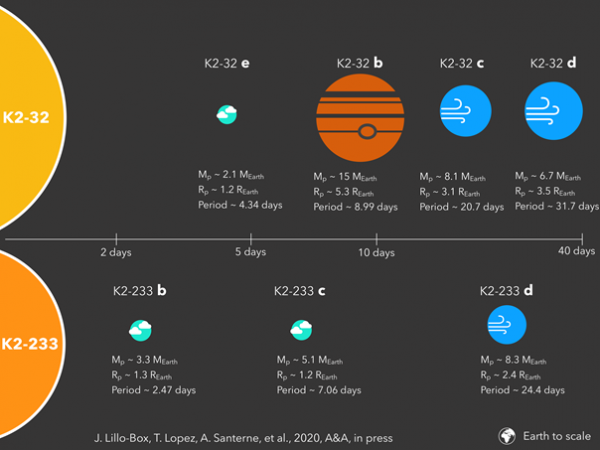Three Earth-like planets identified in two planetary systems

PlanetS astronomers associated with an international team have estimated the density of the planets in two planetary systems. Discovered by the Kepler satellite, K2-32 and K2-233 are planetary systems with 4 and 3 planets respectively. The diameters of the planets have been measured by Kepler thanks to the transit method which uses the obscuration of the star when the planet passes in front of it. It was then necessary to measure the mass in order to obtain the density. The researchers therefore used the HARPS spectrograph designed and built in Geneva and installed at the La Silla Observatory in Chile.
The four planets in the K2-32 system are of particular interest to astronomers because they are small and rocky and therefore reminiscent of our solar system on a smaller scale. In addition, they form a chain of resonance that could provide crucial information on the history of their formation and evolution. Indeed the orbital periods of the planets around K2-32 have the ratios of 1:2:5:7 which also provides information on the process of migration of the planets.
Even if the planets of K2-233 do not present a resonance chain, they are not at all that uninteresting. According to Kepler’s data they are also small and rocky and more over they orbit a young star. This is the first time that researchers have been able to estimate the density of small planets revolving around a star younger than a billion years (360 millions).

Figure 1 Light curves of K2-32 from Kepler: On the top, raw light curve, with transits marked with colored dots. Middle: Smoothed and normalized curve with transits Bottom: phase folded light curve for each planet
According to the results deduced from Kepler’s photometric data, the planets of both systems have the following characteristics:
For K2-32 shown in Figure 1, from the closest to the farthest from the star the planets have radii of 1.2, 5.3, 3.1 and 3.5 Earth radii with orbital periods of 4.3, 9, 21 and 32 days respectively. For K2-233 they have radii of 1.3, 1.3 and 2.4 earth radii with periods of 2.5, 7 and 24.4 days. In summary they are two relatively compact planetary systems (Mercury revolves around the Sun in 88 days) with equally small planets (the largest being barely larger than Neptune).
Characterization, calculation of densities
To determine the masses, and consequently the densities of these 7 planets, the astronomers took some 124 measurements of radial velocities of K2-233 with the HARPS spectrograph and 199 measurements of K2-32 to which they added 45 public measurements. By measuring variations in the radial velocities of stars due to the gravitational influence of a planet, scientists can determine the mass of the planet that causes the star to oscillate. This technique has been widely used since Michel Mayor and Didier Queloz, developed it for the discovery of the first exoplanet in 1995 and for which they received the Nobel Prize last year.
Once the radial velocities have been established, the influence of stellar activity on them must also be taken into account. For example, the star may be subject to pulsations or contain spots that could be interpreted as the presence of one or more planets. This is why knowledge of the star is paramount. The researchers used stellar models based on photometric measurements to determine the characteristics of the two stars. « Measuring the mass of planets in such systems is tricky as the stellar activity signal is many times larger than the Doppler motion induced by the planets » explains Louise Dyregaard Nielsen from the Geneva University and co-author of the research.

Figure 2 Radial velocities curve for K2-233: Top curve: raw data with the influence of the 3 planets and stellar activity. Middle curve: data after eliminating contributions due to stellar activity, the curve in black reflects the presence of the three planets according to a Keplerian model.
Bottom curve: difference between the Keplerian model plus the model of stellar activity and the data (residuals).
Three Earths?
The characteristics of the K2-32 system are detailed in Figure 3. « It is noteworthy that the architecture of this system looks a bit like a reduced version of the solar system, with an inner rocky planet followed by a gas giant (sub-Saturnal density) and two outer mini-Neptunes » says Louise Dyregaard Nielsen, « the system however is densely packed with more than 30 earth masses within less than Mercury’s orbit »

Figure 3: Graphic representation of the two planetary systems K2-32 and K2-233
As for the K2-233 system, shown in the same figure, it is quite different with two small rocky planets and a Neptune. However, this is the first time that a planetary system linked to a young star has been characterized and that rocky planets have been identified around this type of star. After the discovery of rocky planets around solar-type stars, then around cold stars, the detection of a small planet around a young star brings an additional brick to the understanding of the history of the formation of exoplanets.
These three small rocky planets that might resemble the Earth quickly raise the question of whether life could develop on one of them. The researchers have therefore used their models to answer this question, which is answered in the negative. Indeed the estimated temperatures are 1060 °K for K2-32e, 1170 °K for K2-233b and 820 °K for K2-233c, all incompatible with a possible presence of life.
Reference:
Masses for the seven planets in K2-32 and K2-233. Four diverse planets in resonant chain and the first young rocky worlds, Lillo-Box, T. A. Lopez, A. Santerne, L. D. Nielsen, S.C.C. Barros, M. Deleuil, L. Acuña, O. Mousis, S. G. Sousa, V. Adibekyan, D. J. Armstrong, D. Barrado, D. Bayliss, D. J. A. Brown, O.D.S. Demangeon, X. Dumusque, P. Figueira, S. Hojjatpanah, H. P. Osborn, N. C. Santos, S. Udry
https://arxiv.org/abs/2006.01102
Categories: Internal Newsletter, News
